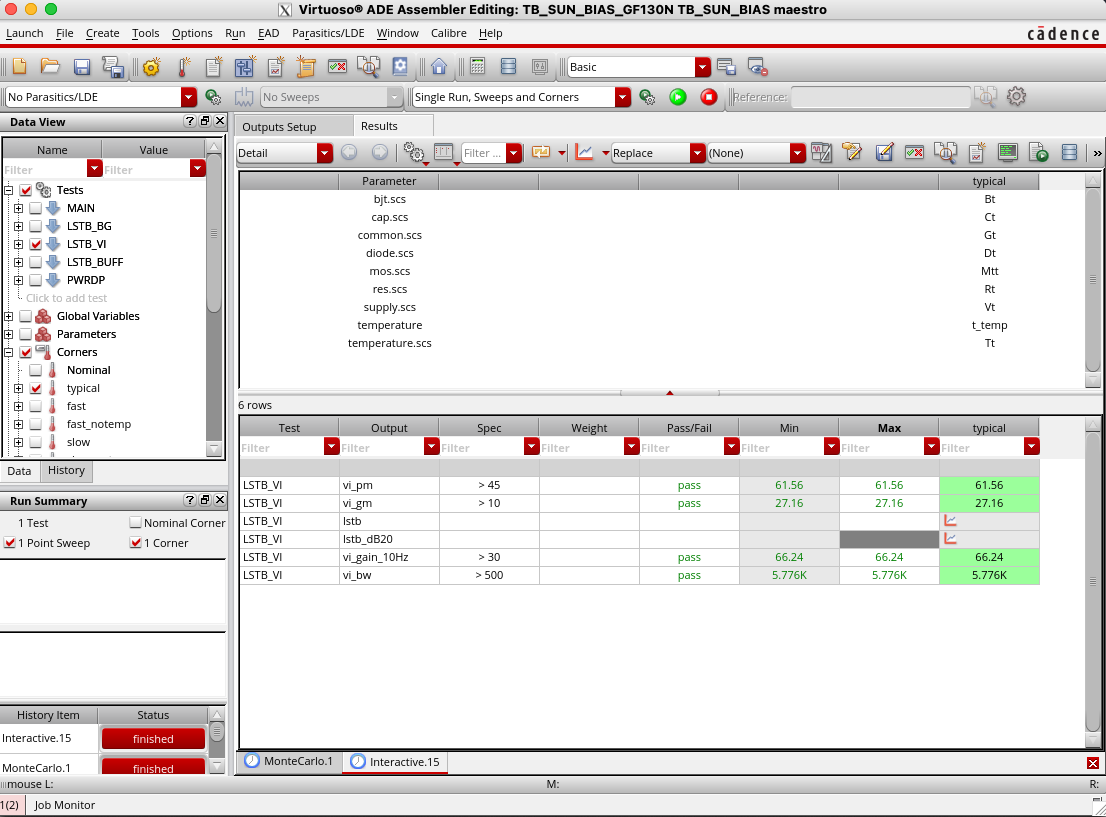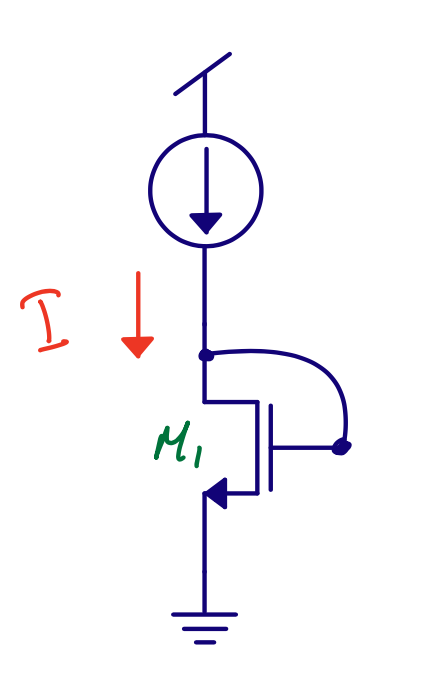SPICE
If you find an error in what I’ve made, then fork, fix lectures/l00_spice.md, commit, push and create a pull request. That way, we use the global brain power most efficiently, and avoid multiple humans spending time on discovering the same error.
- SPICE
- Simulation Program with Integrated Circuit Emphasis
- Find right transistor sizes
- More information
- Analog Design
- Demo
SPICE
Simulation Program with Integrated Circuit Emphasis
To manufacture an integrated circuit we have to be able to predict how it’s going to work. The only way to predict is to rely on our knowledge of physics, and build models of the real world in our computers.
One simulation strategy for a model of the real world, which absolutely every single integrated circuit in the world has used to come into existence, is SPICE.
Published in 1973 by Nagel and Pederson
SPICE (Simulation Program with Integrated Circuit Emphasis)

Today
There are multiple SPICE programs that has been written, but they all work in a similar fashion. There are expensive ones, closed source, and open source.
Some are better at dealing with complex circuits, some are faster, and some are more accurate. If you don’t have money, then start with ngspice.
Commercial Cadence Spectre Siemens Eldo Synopsys HSPICE
Free Aimspice Analog Devices LTspice
Open Source ngspice
But
All SPICE simulators understand the same language (yes, even spectre can speak SPICE). We write our testbenches in a text file, and give it to the SPICE program. That’s the same for all programs. Some may have built fancy GUI’s to hide the fact that we’re really writing text files, but text files is what is under the hood.
Pretty much the same usage model as 48 years ago
<spice program> testbench.cir
for example
ngspice testbench.cir
Or in the most expensive analog tool (Cadence Spectre)
spectre input.scs +escchars +log ../psf/spectre.out
-format psfxl -raw ../psf +aps +lqtimeout 900 -maxw 5 -maxn 5 -env ade -ahdllibdir
/tmp/wulff/virtuoso/TB_SUN_BIAS_GF130N/TB_SUN_BIAS/maestro/results/maestro/Interactive.15/sharedData/CDS/ahdl/input.ahdlSimDB
+logstatus
The expensive tools have built graphical user interface around the SPICE simulator to make it easier to run multiple scenarios.
| Corner | Typical | Fast | Slow | All |
|---|---|---|---|---|
| Mosfet | Mtt | Mff | Mss | Mff,Mfs,Msf,Mss |
| Resistor | Rt | Rl | Rh | Rl,Rh |
| Capacitors | Ct | Cl | Ch | Cl,Ch |
| Diode | Dt | Df | Ds | Df,Ds |
| Bipolar | Bt | Bf | Bs | Bf,Bs |
| Temperature | Tt | Th,Tl | Th,Tl | Th,Tl |
| Voltage | Vt | Vh,Vl | Vh,Vl | Vh,Vl |

I’m a fan of launching multiple simulations from the command line. I don’t like GUI’s. As such, I wrote cicsim, and that’s what I use in the video and demo.
Sources
The SPICE language is a set of conventions for how to write the text files. In general, it’s one line, one command (although, lines can be continued with a +).
I’m not going to go through an extensive tutorial in this document, and there are dialects with different SPICE programs. You’ll find more info at ngspice
Independent current sources
Infinite output impedance, changing voltage does not change current
I<name> <from> <to> dc <number> ac <number>
I1 0 VDN dc In
I2 VDP 0 dc Ip
Independent voltage source
Zero output impedance, changing current does not change voltage
V<name> <+> <-> dc <number> ac <number>
V2 VSS 0 dc 0
V1 VDD 0 dc 1.5
Passives
Resistors
R<name> <node 1> <node 2> <value>
R1 N1 N2 10k
R2 N2 N3 1Meg
R3 N3 N4 1G
R4 N4 N5 1T
Capacitors
C<name> <node 1> <node 2> <value>
C1 N1 N2 1a
C2 N1 N2 1f
C4 N1 N2 1p
C3 N1 N2 1n
C5 N1 N2 1u
Transistor Models
Needs a model file the transistor model
BSIM (Berkeley Short-channel IGFET Model) http://bsim.berkeley.edu/models/bsim4/
284 parameters in BSIM 4.5
.MODEL N1 NMOS LEVEL=14 VERSION=4.5.0 BINUNIT=1 PARAMCHK=1 MOBMOD=0
CAPMOD=2 IGCMOD=1 IGBMOD=1 GEOMOD=1 DIOMOD=1 RDSMOD=0 RBODYMOD=0 RGATEMOD=3
PERMOD=1 ACNQSMOD=0 TRNQSMOD=0 TEMPMOD=0 TNOM=27 TOXE=1.8E-009
TOXP=10E-010 TOXM=1.8E-009 DTOX=8E-10 EPSROX=3.9 WINT=5E-009 LINT=1E-009
LL=0 WL=0 LLN=1 WLN=1 LW=0 WW=0 LWN=1 WWN=1 LWL=0 WWL=0 XPART=0
TOXREF=1.4E-009 SAREF=5E-6 SBREF=5E-6 WLOD=2E-6 KU0=-4E-6 KVSAT=0.2
KVTH0=-2E-8 TKU0=0.0 LLODKU0=1.1 WLODKU0=1.1 LLODVTH=1.0 WLODVTH=1.0
LKU0=1E-6 WKU0=1E-6 PKU0=0.0 LKVTH0=1.1E-6 WKVTH0=1.1E-6 PKVTH0=0.0
STK2=0.0 LODK2=1.0 STETA0=0.0 LODETA0=1.0 LAMBDA=4E-10 VSAT=1.1E 005
VTL=2.0E5 XN=6.0 LC=5E-9 RNOIA=0.577 RNOIB=0.37
LINTNOI=1E-009 WPEMOD=0 WEB=0.0 WEC=0.0 KVTH0WE=1.0 K2WE=1.0 KU0WE=1.0
SCREF=5.0E-6 TVOFF=0.0 TVFBSDOFF=0.0 VTH0=0.25 K1=0.35 K2=0.05
K3=0 K3B=0 W0=2.5E-006 DVT0=1.8 DVT1=0.52 DVT2=-0.032 DVT0W=0 DVT1W=0
DVT2W=0 DSUB=2 MINV=0.05 VOFFL=0 DVTP0=1E-007 DVTP1=0.05 LPE0=5.75E-008
LPEB=2.3E-010 XJ=2E-008 NGATE=5E 020 NDEP=2.8E 018 NSD=1E 020 PHIN=0
CDSC=0.0002 CDSCB=0 CDSCD=0 CIT=0 VOFF=-0.15 NFACTOR=1.2 ETA0=0.05
ETAB=0 UC=-3E-011 VFB=-0.55 U0=0.032 UA=5.0E-011 UB=3.5E-018 A0=2
AGS=1E-020 A1=0 A2=1 B0=-1E-020 B1=0 KETA=0.04 DWG=0 DWB=0 PCLM=0.08
PDIBLC1=0.028 PDIBLC2=0.022 PDIBLCB=-0.005 DROUT=0.45 PVAG=1E-020
DELTA=0.01 PSCBE1=8.14E 008 PSCBE2=5E-008 RSH=0 RDSW=0 RSW=0 RDW=0
FPROUT=0.2 PDITS=0.2 PDITSD=0.23 PDITSL=2.3E 006 RSH=0 RDSW=50 RSW=150
RDW=150 RDSWMIN=0 RDWMIN=0 RSWMIN=0 PRWG=0 PRWB=6.8E-011 WR=1
ALPHA0=0.074 ALPHA1=0.005 BETA0=30 AGIDL=0.0002 BGIDL=2.1E 009 CGIDL=0.0002
EGIDL=0.8 AIGBACC=0.012 BIGBACC=0.0028 CIGBACC=0.002 NIGBACC=1
AIGBINV=0.014 BIGBINV=0.004 CIGBINV=0.004 EIGBINV=1.1 NIGBINV=3 AIGC=0.012
BIGC=0.0028 CIGC=0.002 AIGSD=0.012 BIGSD=0.0028 CIGSD=0.002 NIGC=1
POXEDGE=1 PIGCD=1 NTOX=1 VFBSDOFF=0.0 XRCRG1=12 XRCRG2=5 CGSO=6.238E-010
CGDO=6.238E-010 CGBO=2.56E-011 CGDL=2.495E-10 CGSL=2.495E-10
CKAPPAS=0.03 CKAPPAD=0.03 ACDE=1 MOIN=15 NOFF=0.9 VOFFCV=0.02 KT1=-0.37
KT1L=0.0 KT2=-0.042 UTE=-1.5 UA1=1E-009 UB1=-3.5E-019 UC1=0 PRT=0
AT=53000 FNOIMOD=1 TNOIMOD=0 JSS=0.0001 JSWS=1E-011 JSWGS=1E-010 NJS=1
IJTHSFWD=0.01 IJTHSREV=0.001 BVS=10 XJBVS=1 JSD=0.0001 JSWD=1E-011
JSWGD=1E-010 NJD=1 IJTHDFWD=0.01 IJTHDREV=0.001 BVD=10 XJBVD=1 PBS=1 CJS=0.0005
MJS=0.5 PBSWS=1 CJSWS=5E-010 MJSWS=0.33 PBSWGS=1 CJSWGS=3E-010 MJSWGS=0.33
PBD=1 CJD=0.0005 MJD=0.5 PBSWD=1 CJSWD=5E-010 MJSWD=0.33 PBSWGD=1
CJSWGD=5E-010MJSWGD=0.33 TPB=0.005 TCJ=0.001 TPBSW=0.005 TCJSW=0.001 TPBSWG=0.005
TCJSWG=0.001 XTIS=3 XTID=3 DMCG=0E-006 DMCI=0E-006 DMDG=0E-006 DMCGT=0E-007 DWJ=0.0E-008 XGW=0E-007
XGL=0E-008 RSHG=0.4 GBMIN=1E-010 RBPB=5 RBPD=15 RBPS=15 RBDB=15 RBSB=15 NGCON=1
JTSS=1E-4 JTSD=1E-4 JTSSWS=1E-10 JTSSWD=1E-10 JTSSWGS=1E-7 JTSSWGD=1E-7 NJTS=20.0
NJTSSW=20 NJTSSWG=6 VTSS=10 VTSD=10 VTSSWS=10 VTSSWD=10 VTSSWGS=2 VTSSWGD=2
XTSS=0.02 XTSD=0.02 XTSSWS=0.02 XTSSWD=0.02 XTSSWGS=0.02 XTSSWGD=0.02
Transistors
M<name> <drain> <gate> <source> <bulk> <modelname> [parameters]
M1 VDN VDN VSS VSS nmos W=0.6u L=0.15u
M2 VDP VDP VDD VDD pmos W=0.6u L=0.15u
Foundries
Each foundry has their own SPICE models bacause the transistor parameters depend on the exact physics of the technology!
https://skywater-pdk.readthedocs.io/en/main/
Find right transistor sizes
Assume active (\(V_{ds} > V_{eff}\) in strong inversion, or \(V_{ds} > 3 V_T\) in weak inversion). For diode connected transistors, that is always true.
Weak inversion: \(I_{D} = I_{D0} \frac{W}{L} e^{V_eff / n V_T}\), \(V_{eff} \propto \ln{I_D}\)
Strong inversion: \(I_{D} = \frac{1}{2} \mu_n C_{ox} \frac{W}{L} V_{eff}^2\), \(V_{eff} \propto \sqrt{I_D}\)
Operating region for a diode connected transistor only depends on the current

Use unit size transistors for analog design
\(W/L \approx \in[4, 6, 10]\), but should have space for two contacts
Use parallel transistors for larger W/L
Amplifiers \(\Rightarrow L \approx 1.2 \times L_{min}\)
Current mirrors \(\Rightarrow L \approx 4 \times L_{min}\)
Choose sizes that have been used by foundry for measurement to match SPICE model
What about gm/Id ?
Weak \(\frac{g_m}{I_d} = \frac{1}{nV_T}\)
Strong \(\frac{g_m}{I_d} = \frac{2}{V_{eff}}\)
Characterize the transistors
http://analogicus.com/cnr_atr_sky130nm/mos/CNRATR_NCH_2C1F2.html
More information
Analog Design
- Define the problem, what are you trying to solve?
- Find a circuit that can solve the problem (papers, books)
- Find right transistor sizes. What transistors should be weak inversion, strong inversion, or don’t care?
- Check operating region of transistors (.op)
- Check key parameters (.dc, .ac, .tran)
- Check function. Exercise all inputs. Check all control signals
- Check key parameters in all corners. Check mismatch (Monte-Carlo simulation)
- Do layout, and check it’s error free. Run design rule checks (DRC). Check layout versus schematic (LVS)
- Extract parasitics from layout. Resistance, capacitance, and inductance if necessary.
- On extracted parasitic netlist, check key parameters in all corners and mismatch (if possible).
- If everything works, then your done.
On failure, go back
